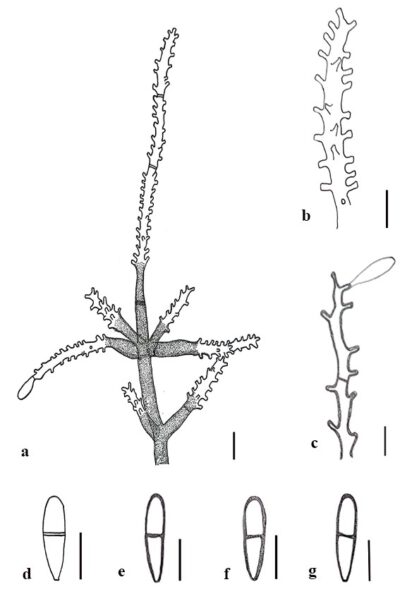Fungalpedia – Note 172, Zelodactylaria
Zelodactylaria A.C. Cruz, Gusmão & R.F. Castañeda
Citation when using this entry: Madagammana et al. 2024 (in prep) – Fungalpedia, genera described in 2012.
Index Fungorum, Facesoffungi, MycoBank, GenBank, Fig. 1.
Classification: Pezizomycotina, Ascomycota, Fungi
Zelodactylaria is an asexual genus introduced by Cruz et al. (2012), based on morphology, with Z. verticillata as the type of species. Zelodactylaria is characterized by effuse, hairy, brown to olivaceous or black colonies, and superficial, immersed mycelia composed of septate, branched, brown hyphae. The conidiophores are macronematous, mononematous, erect, septate, brown or black, smooth or verruculose. They produce verticillate, branched, polyblastic conidiogenous cells that are discrete, sympodially proliferate, and denticulate. The conidial secession is schizolytic, and the conidia are solitary, clavate, obovoid to globose, septate, smooth or verruculose, and hyaline(Cruz et al. 2012).
Based on sympodial proliferation with denticulate conidiogenous cells, Zelodactylaria resembles Calcarisporium, Dactylaria, Pleurophragmium, Selenosporella, Selenosporopsis, Tritirachium, and Umbellidion; however, distinguishes by verticillate ramification (Cruz et al. 2012). Additional characteristics that distinguish these genera from Zelodactylaria include the following: Selenosporella and Selenosporopsis produce filiform to falcate, unicellular conidia in short and long denticulate conidiogenous loci; Calcarisporium develops conidiogenous loci at the top of each branch; Tritirachium exhibits inconspicuous scars in a long geniculate rachis, and Umbellidion has conidiogenous cells arranged in umbels, with several short, unthicken, inconspicuous denticles that are restricted to the apices, and aseptate conidia (Cruz et al. 2012). Due to the lack of sequence data, this genus is listed under the Ascomycota genera incertae sedis (Wijayawardene et al. 2022). Therefore, additional taxon sampling and sequence data are required to confirm the phylogenetic position. Only one species is listed in Index Fungorum (2023), which was collected on the decaying bark of an unidentified plant from Brazil (Cruz et al. 2012).
Type species: Zelodactylaria verticillata A.C. Cruz, Gusmão & R.F. Castañeda
Figure 1 – Zelodactylaria verticillata (HUEFS169132, holotype). a Conidiophore. b, c Conidiogenous cells. d-g Conidia. Scale bars: a-g = 10 μm. Redrawn from Cruz et al. (2012).
References
Entry by
Ashani D. Madagammana, Center of Excellence in Fungal Research, Mae Fah Luang University, Chiang Rai, 57100, Thailand; School of Science, Mae Fah Luang University, Chiang Rai, 57100, Thailand.
(Edited by Chitrabhanu S. Bhunjun, Subodini N. Wijesinghe, Samaneh Chaharmiri-Dokhaharani, & Achala R. Rathnayaka)
Published online 10 January 2024
